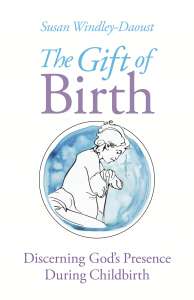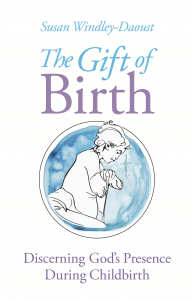“They were ‘doing birth’ to me rather than helping me ‘give birth,’” writes Susan Windley-Daoust of her first experience of childbirth, which she had hoped to do naturally but that instead resulted in “failure to progress” and a C-section. “That birth experience ended up being spiritually abusive by the ongoing treatment of me as an object (and not just an object; close to an object of ridicule). My experience may have been worse than some, but it was not that unusual” (14).
So many women are terrified at the notion or scarred by the past experience of giving birth in the U.S. today. In The Gift of Birth: Discerning God’s Presence During Childbirth, Windley-Daoust speaks to the need for healing and also for truth: for women to recognize and reject the culturally accepted, destructive lie that “childbirth will break you: you can’t do it without the drugs; that’s just life and it needs to be this way” (14). Her first birth gave her the impetus to be “extremely intentional and attentive” to her three subsequent birth experiences. Not only does childbirth not have to be horrific, she writes, but it can also provide a unique space in which to receive divine grace and wisdom: “The act of giving birth can be a teaching moment in the spiritual life, and a moment of grace. The dignity of birthing emphatically needs to be spoken to in spiritual ways” (15).
With The Gift of Birth Windley-Daoust offers Christian women a pastoral guide for uncovering the dignity and meaning inherent in pregnancy and birth. It is very user-friendly, with short chapters that are both down-to-earth and theologically grounded—each of which ends with practical suggestions, food for thought, and prayers to adopt—without descending into the saccharine. She brings together the Jesuit tradition of spiritual direction, St. John Paul II’s Theology of the Body, and elements of the Bradley Method of Natural Childbirth, crafted as a resource for reflection and prayer during pregnancy.
Indeed, Windley-Daoust’s book speaks to a “sad lack of Christian-specific materials” to prepare for birth (17). While many popular works on the Theology of the Body are available, this one extends John Paul II’s vision of embodiment, sexuality, and relationship into an application of understanding the natural next step in that trajectory: procreation and the welcoming of new life.
The book is divided into four sections: 1) the Theology of the Body and childbirth, 2) reading the signs of birth, 3) discerning God’s presence when things don’t go as planned, and 4) birth stories from Catholic women.
The first section serves as a brief introduction to Theology of the Body in connection with the experience of pregnancy and birth, and especially to John Paul II’s “Law of the Gift”: “that we become most fully ourselves in covenantal relationships through the dynamic of giving and receiving” (12). It also includes an interesting look at the language of Scripture regarding “what is confusing for many Christians: how birth can be a gift when we read in Genesis 3:16… ‘in pain you shall bring forth children’” (18).
The second section offers reflections on how prominent physical and emotional signs in the process of giving birth ‘speak’ to us spiritually (first contractions, active labor, transition, etc.). Here the influence of the Bradley Method of birth preparation comes through more practically, with short descriptions of each stage of labor to introduce each chapter.
The chapter on the transition stage is especially salient, since transition is almost always marked by overwhelming self-doubt. Windley-Daoust connects this marker (which usually comes shortly before the pushing stage) with the fundamental need of each human person for God, a universal spiritual poverty that requires salvation in and through the Spirit. She also evokes the scriptural image from Paul’s Letter to the Romans of the whole of Creation groaning in labor pains, as she ties this image to the practical advice of “sounding” (or low-pitched groaning) (cf. 83–85).
The chapter’s strength stems from the universality of the problem: spiritual hopelessness in the face of utter exhaustion and a depletion of resources. This is considered the most difficult part of labor, but overcoming it with divine and human help can be that much more powerful because of the struggle and the surrender. What person does not experience a parallel to this in his or her own faith life? For a woman to experience it wholly, until she receives the reward of meeting her baby for the first time face-to-face, can be an experience. As one mother describes it, “I felt as though my husband and I were with God at the dawn of Creation. Nothing . . . brought me as close to a sense of God creating and loving his Creation . . . as that morning when the air was as pure as the day after a storm and God’s power and love flooded the room” (7).
In contrast, the third section “ponders what happens when things do not go according to plan.” It treats such realities as unexpected pregnancy, miscarriage, stillbirth, high-risk birth, and post-partum depression with thoughtful guidance, stemming from a place of gravitas and sensitivity appropriate to the subject matter. I found this section to be a strong point and perhaps one of the most sorely-needed in Catholic pastoral resources today. From the chapter on miscarriage and stillbirth, for example:
All of us who bear children have to acknowledge, sooner or later, that we are caretakers: that children have been given to us for a time—days, weeks, years—and we are called to care for them in that time. . . . The greatest and hardest mothering act we can do, after placing our grief or confusion or numbness in God’s hands as an act of trust, is to place our children in his arms. You are not renouncing your motherhood, nor has it been taken away. You are fulfilling it. (116)
The fourth section features a series of birth stories and interviews with Catholic mothers with a range of positive and negative experiences, but always with a sense of how God was present in their birthing, even if only in retrospect. I never understood why people share the details of their birth stories until a short time before I was to give birth for the first time—at which point I realized how formative it could be to realize that every labor is different, and that there are all kinds of “normal” that are possible.
The Bradley Method fits well into the author’s approach because it regards a woman as naturally capable of birth (“Women’s bodies and souls were created by God to be able to do this very thing: to give birth,” as Windley-Daoust writes). Bradley takes seriously the complex psychosomatic union that Catholicism also espouses (cf. n. 4, p. 164). The Bradley Method is not religiously affiliated, but rather is a scientifically-based approach that actively involves the husband or birth coach (from pregnancy through labor) in order to equip the laboring woman with tools to give birth without medication.
Two key elements of the Bradley approach make a great deal of sense for the Catholic couple: 1) regard for the woman as a whole person, whose mind and body are inextricably linked, and 2) a vision of the birth as something to be undertaken as a husband-wife team. For couples who chart cycles and employ Natural Family Planning, the Bradley Method can be used as a similarly useful tool in taking up the particulars of growing a family in a way that fosters unity and a deepening of relationship.
This book gets to the heart of the problem with our society’s understanding and treatment of pregnant and laboring women and offers an extremely refreshing, well-rooted vision of not only childbirth but also of personhood in relation to God. Culturally,
we treat the body apart from the soul. We increasingly see the body as a machine, perhaps a beautiful one, but one we can name and manipulate and control. We lose the sense of the body as a sign to be read, the form of the soul, and see it instead as an instrument to be used. We lose the heart of what it means to be human, a unity of body and soul. (12)
It is precisely the author’s nuanced theology of personhood, honed in her academic and pastoral contexts, that makes The Gift of Birth as valuable and timely of a resource as it is. Indeed, the book constitutes one step in providing women with much-lacking pastoral accompaniment in the embodied experience particular to women in the Church today.
Windley-Daoust therefore illustrates in myriad ways, with the help of the mothers she interviewed, how the Cross of labor leads into the Easter Sunday miracle of a new human being looking her parents in the face for the first time. But even more than that, she demonstrates how women might learn to understand, in the nitty-gritty details of birth, the very real presence of God in and through the experience of becoming a mother: “Childbirth has a spiritual meaning that goes beyond the existence of new life—as profound as that is. Childbirth teaches us how to make room for God, receive grace, and live in relationship with the Holy Spirit” (10).
Tania M. Geist is the managing editor of Church Life Journal.



